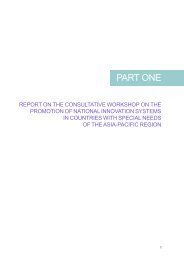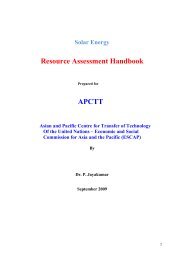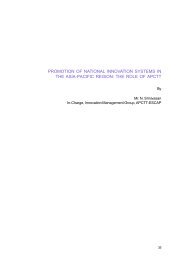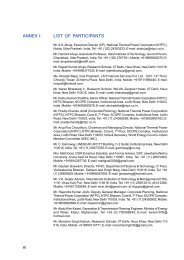a near-constant, speed-variable power arrangement. In stand-alone small hydro units(say up to 100 kW) – typically classified as micro, pico and nano hydro systems – itis apt to use uncontrolled constant power turbines with constant head and discharge.Thus, the generated power is always constant while the consumer load varies. Anautomatic load controller is needed to ensure that controllable additional load is phasedby the generator such that the total output power is constant at varying consumerloads. Wind energy, on the other hand, provides varying power as cube of wind speed.Thus, output power must always match this wind power. For this, power balancers areneeded for all wind speeds and loads through dump loads and additional source orstorage system. In solar PV systems, power output is DC and depends on lightintensity, thus needing a controller and inverter. A combination of renewable energysources in hybrid mode, which may involve storage systems like a battery, could alsobe explored.1. Bio-energyDifferent types of biofuels can be converted to liquids or gases to feed an engine todrive a generator, which in turn will energize the local load. The energy system may besimilar to the small petrol/kerosene-driven generator sets (1-10 kW) that are commonin domestic and commercial sectors. Such units are in use in ships, boats, camping,tourism, military and other stand-alone, off-grid applications. Biofuel can replace fossilfuel in these engines, with synchronous or induction generators. Power quality atgeneration, transmission and load levels should be ensured under varying magnitudeand types of loads (1-phase, 3-phase, balanced, unbalanced, linear and non-linear).While petroleum is readily available for use in engines, the user must install a systemto convert the available bio-energy source to a form compatible with the engine. Apartfrom sizing and design of the engine for a given load, its performance with biofuel mustbe assessed. Suitable electrical system – comprising the generator, control andtransmission – should be evolved. Unit sizes may vary from 5 kW to 100 kW andbeyond. It has near-constant speed prime mover with a typical speed drop of 5 percent from no load to full load via governor control. The engine operates at varying inputpower by adjusting fuel intake decided by output power. Indian R&D institutions havecarried out considerable work with great promise on energy conversion systems. Thereare some success stories such as ‘husk power’ in Bihar, where power is generatedfrom rice husk for local communities. A comprehensive list of examples of Indianexperience in bio-energy may be prepared and required support provided for promisinginventions in terms of technology transfer as well as for deployment in rural areas withutilization of local bio-energy resources.2. Small hydro energyMicro or pico hydro units in off-grid mode can be installed for local loads in remotelocations with favourable hydro potential needing minimal civil works. For off-gridapplications, uncontrolled turbine or ‘pump as turbine’ in constant power mode is moreapt since head and discharge at turbine end are constant with specific water headnaturally available in a site. Since consumer power varies randomly, surplus powershould either be used or dissipated, and that requires an electronic load controller(ELC). Self-excited induction generator (SEIG), researched in depth at the Indian Instituteof Technology (IIT) Delhi, is a good candidate for such applications, and a few SEIGunits have been installed following the study by IIT Delhi. Power in moving rivers andcanals is the other variant of hydro energy. A vertical axis Darius type turbine installed46
in such a canal will rotate at a low speed, which can be used to produce electricity.However, this demands proper conversion systems and controls to provide qualitypower to local consumers. The task ahead is to consolidate the existing technology,expertise and industry base to standardize on such off-grid hydro systems for largescaledeployment in the Himalayan region and on river basins.3. Wind energyAs already mentioned, both input wind power and output electric power vary randomlyand the challenge is to match them at all instances through a control mechanism. Inits simplest form, connected load can be varied through a switching mechanism tomatch with wind speed. It can be noted from typical wind turbine characteristics fordifferent wind speeds that for any given wind speed, there is one generator speed atwhich the extracted power has maximum value. A maximum power point tracking(MPPT) mechanism is required to take advantage of this. Turbine type, powertransmission and generator should be standardized. The main challenge is to developa suitable control mechanism for energy balance and this needs R&D efforts.4. Solar energyIndia targets 200 MW of off-grid solar energy by 2013 but has so far sanctioned projectsonly for 45 MW. Within the off-grid component, there is a separate target of covering 20million rural households with solar lighting. Similar to wind-based power, the poweroutput from a PV panel varies with the intensity and temperature of sunlight. Fromtypical volt-ampere characteristics of PV panels, the apt load for maximum power canbe determined. Here too, MPPT could be used to adjust the load with the availablemaximum solar power.IVAPPLICATION OF ADVANCED FFT FOR POWER GENERATIONA World Energy Council (WEC) document has made the following observations andsuggestions while discussing realistic energy targets for 2030 and 2050:• At present, 2 billion people do not have access to commercial energy and thisnumber will be halved by 2035;• At present, there are obstacles for transferring “energy sources from where theyare plentiful to where they are needed and converting them to sustainable stationary,electricity and transport”;• The energy sector will need an investment of US$20 trillion by 2030;• International energy trade requires new set of rules to be set to strike a compromisebetween the interests of producers and consumers;• Closer integration of regional and global energy markets is required;• A new international framework for technology transfer is needed;• There is a need to develop local skills;• A global dialogue on security of energy supply and demand needs to be initiated;and• Taxation and legal and commercial frameworks must limit investment risks andfoster realistic expectations for risk and return.47
- Page 1 and 2:
ADVANCES IN FOSSIL FUELTECHNOLOGIES
- Page 3 and 4:
ADVANCES IN FOSSIL FUELTECHNOLOGIES
- Page 5 and 6: CONTENTSABBREVIATIONSiiiPART ONEREP
- Page 7 and 8: ABBREVIATIONSAC : Alternating curre
- Page 9: OECD : Organization for Economic Co
- Page 12 and 13: IORGANIZATION OF THE WORKSHOPA. Bac
- Page 14 and 15: D. Election of officersThe followin
- Page 16 and 17: IIICONSIDERATION OF ISSUESA. Backgr
- Page 18 and 19: emissions. Underground coal gasific
- Page 20 and 21: 800 MWe, a steam pressure of 300 kg
- Page 22 and 23: • Materials development & manufac
- Page 24 and 25: Figure 1-5: Strategy for commercial
- Page 26 and 27: tonnes, the state-owned enterprise
- Page 28 and 29: • Ensuring not just easy FDI entr
- Page 30 and 31: MW ultra-supercritical units; and s
- Page 32 and 33: the captive generation capacity) on
- Page 34 and 35: and other financial institutions -
- Page 36 and 37: and higher efficiency power generat
- Page 38 and 39: energy technologies, which can enab
- Page 40 and 41: • Such massive financial inputs c
- Page 43 and 44: BASELINE REPORT ON FOSSIL FUEL TECH
- Page 45 and 46: B. General R&D climate in the count
- Page 47 and 48: a convenient way to envisage energy
- Page 49 and 50: to mature and become more cost-comp
- Page 51 and 52: emissions, at least relative to sin
- Page 53 and 54: The Ministry of Power (MoP), which
- Page 55: 3. Bio-energyBio-energy, widely ava
- Page 59 and 60: in tackling climate change. A one p
- Page 61 and 62: Advantages of supercritical plants
- Page 63 and 64: existing power plants but also to b
- Page 65 and 66: BASELINE REPORT ON FOREIGN DIRECT I
- Page 67 and 68: CEA at 598 mt. This is mainly due t
- Page 69 and 70: For India to maintain its momentum
- Page 71 and 72: Table 2-5: Electricity generation t
- Page 73 and 74: Growth, which submitted its interim
- Page 75 and 76: 3. Future challengesThe future chal
- Page 77 and 78: development worked out. Public-priv
- Page 79 and 80: Linking FDI to technology transferI
- Page 81 and 82: The total requirement of fund durin
- Page 83 and 84: Funding from multilateral agenciesM
- Page 85 and 86: cooperation will be essential in so
- Page 87: Planning Commission, Government of
- Page 90 and 91: ANNEX I:LIST OF PARTICIPANTSMr. A.K
- Page 92 and 93: Mr. S.C. Shrivastava, Joint Chief (
- Page 94 and 95: ANNEX II:PROGRAMME6 June 2012, Wedn
- Page 96 and 97: ANNEX III:AN OVERVIEW OF ADVANCED F
- Page 98 and 99: • Technology solutions are also v
- Page 100 and 101: Table 3-5: Improvement in cycle eff
- Page 102 and 103: • No liquid effluent formation;
- Page 104 and 105: Figure 3-5: Advancement of gas turb
- Page 106 and 107:
Figure 3-8: Goal 2 - New clean tech
- Page 108 and 109:
Compared with conventional power pl
- Page 110 and 111:
Figure 3-14: Thermax coal gasificat
- Page 112 and 113:
ANNEX VII:GE ENERGY AND ADVANCED FO
- Page 114 and 115:
ANNEX VIII:SWOT ANALYSIS OF FOSSIL
- Page 116 and 117:
By 2035, cumulative CO 2emissions f
- Page 118 and 119:
• Falling prices of renewable ene
- Page 120 and 121:
Figure 3-20: New advanced coal powe
- Page 122 and 123:
ANNEX X:ENERGY CONSERVATION: ERDA
- Page 124 and 125:
Table 3-11: Energy cost and intensi
- Page 126 and 127:
300Figure 3-23: Trends in coal use
- Page 128 and 129:
C. Gaps in coal use efficiencyFigur
- Page 130 and 131:
ANNEX XII:FINANCING OF THE POWER SE
- Page 132 and 133:
With the entry of many private sect
- Page 134 and 135:
for future requirements should be t
- Page 136 and 137:
Short supply of coal has started af
- Page 138:
Figure 3-35: Life-cycle of technolo







